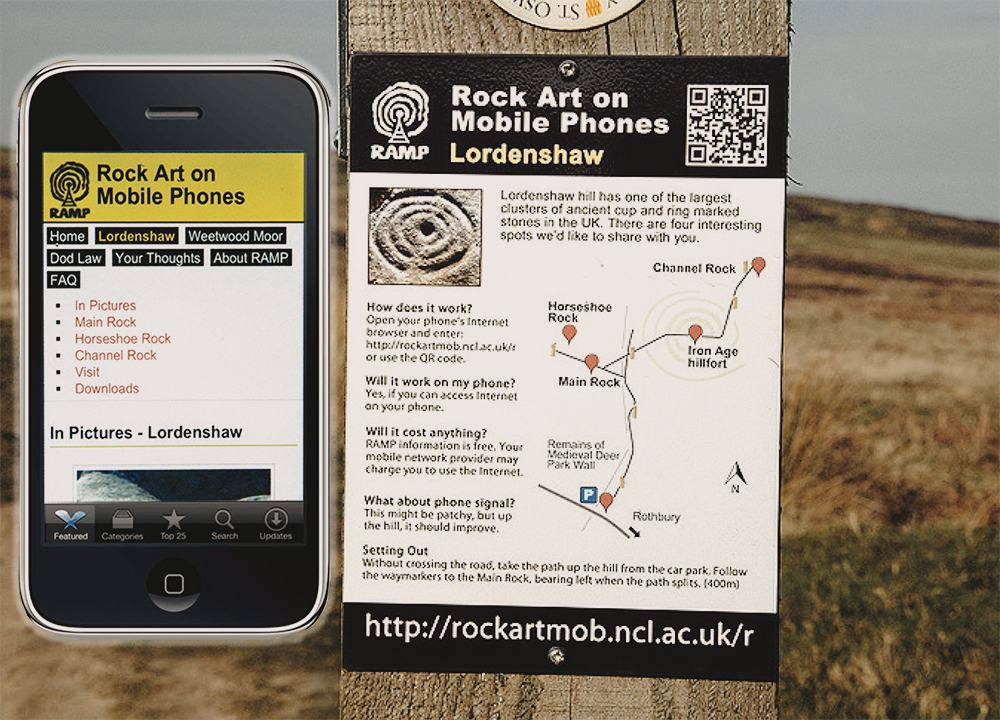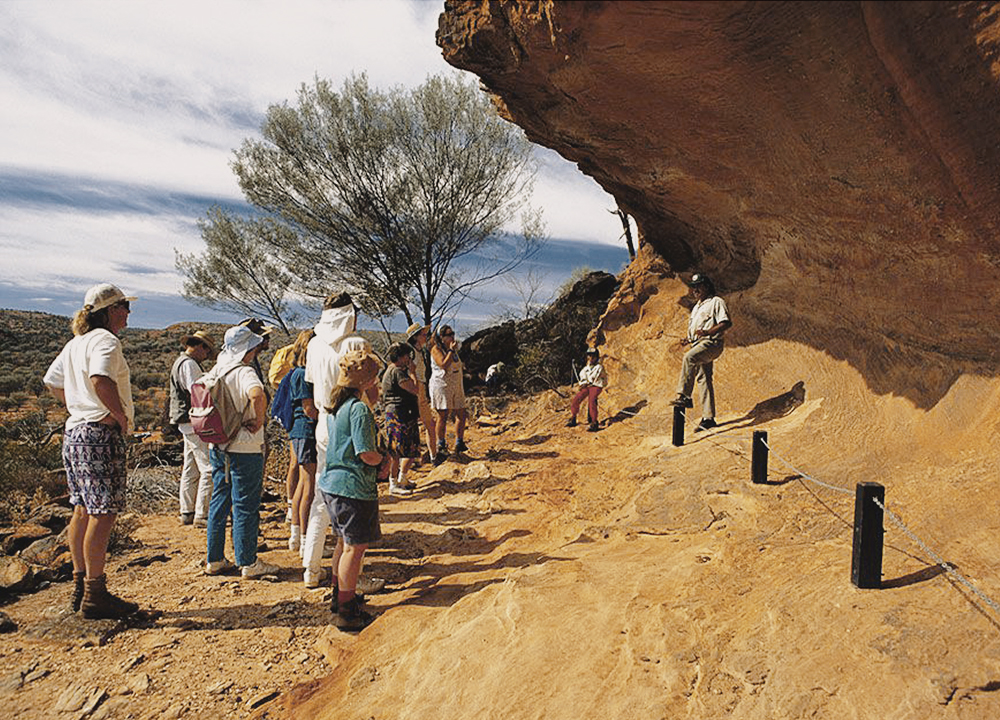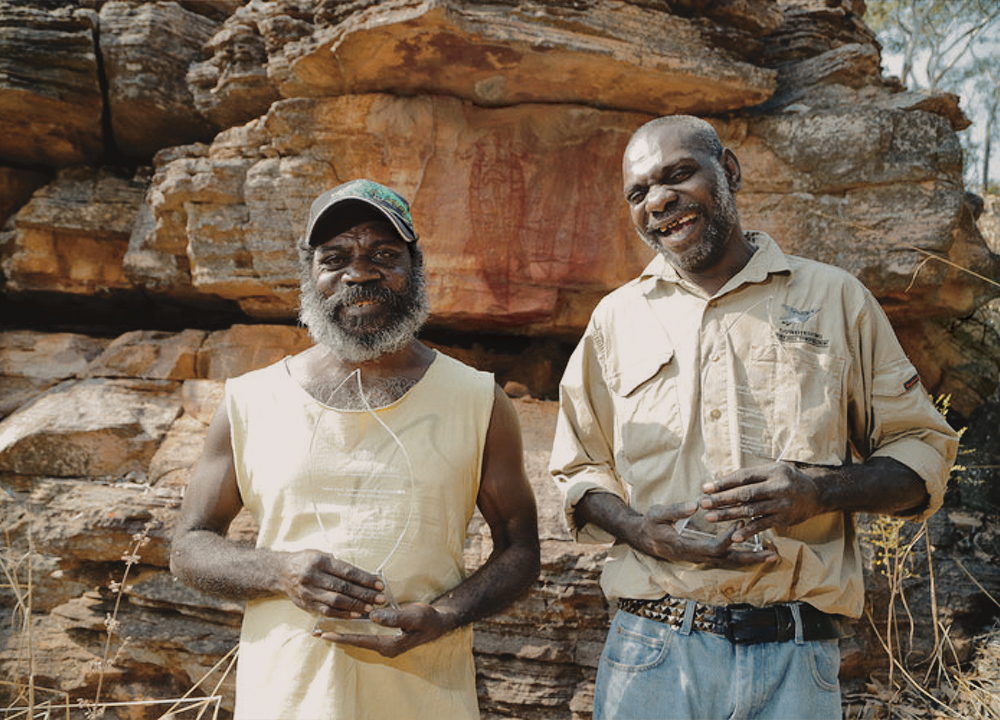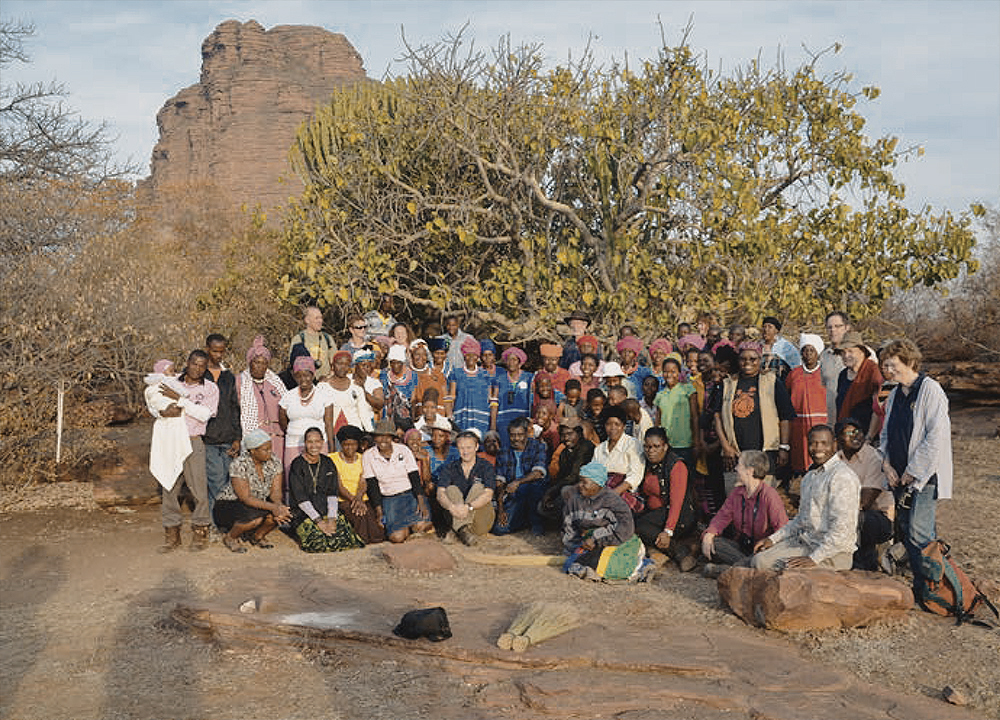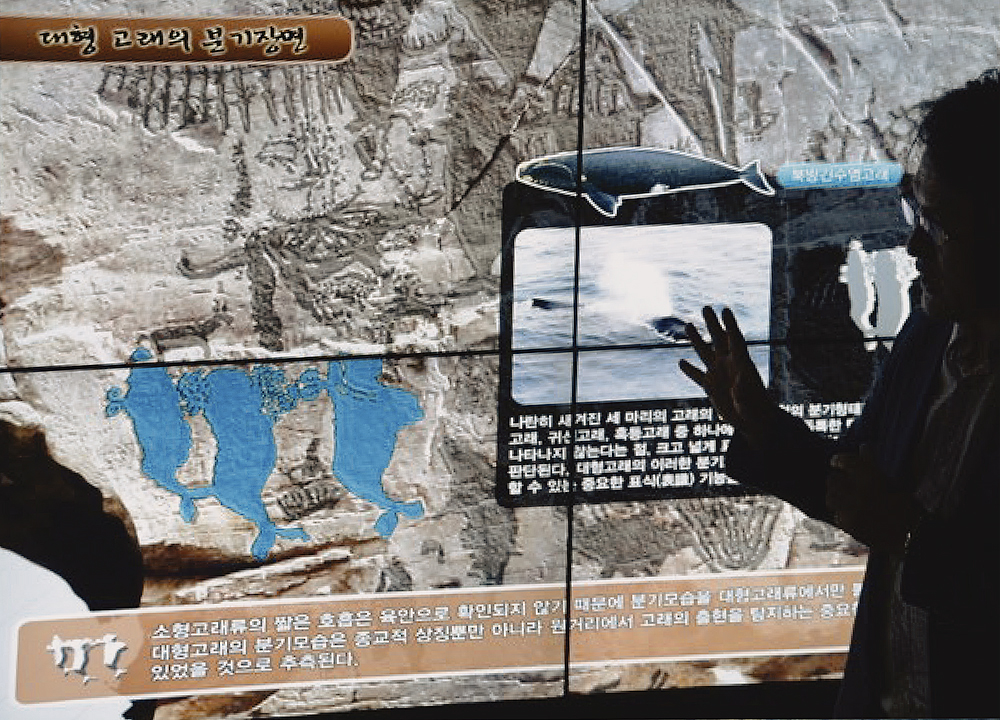
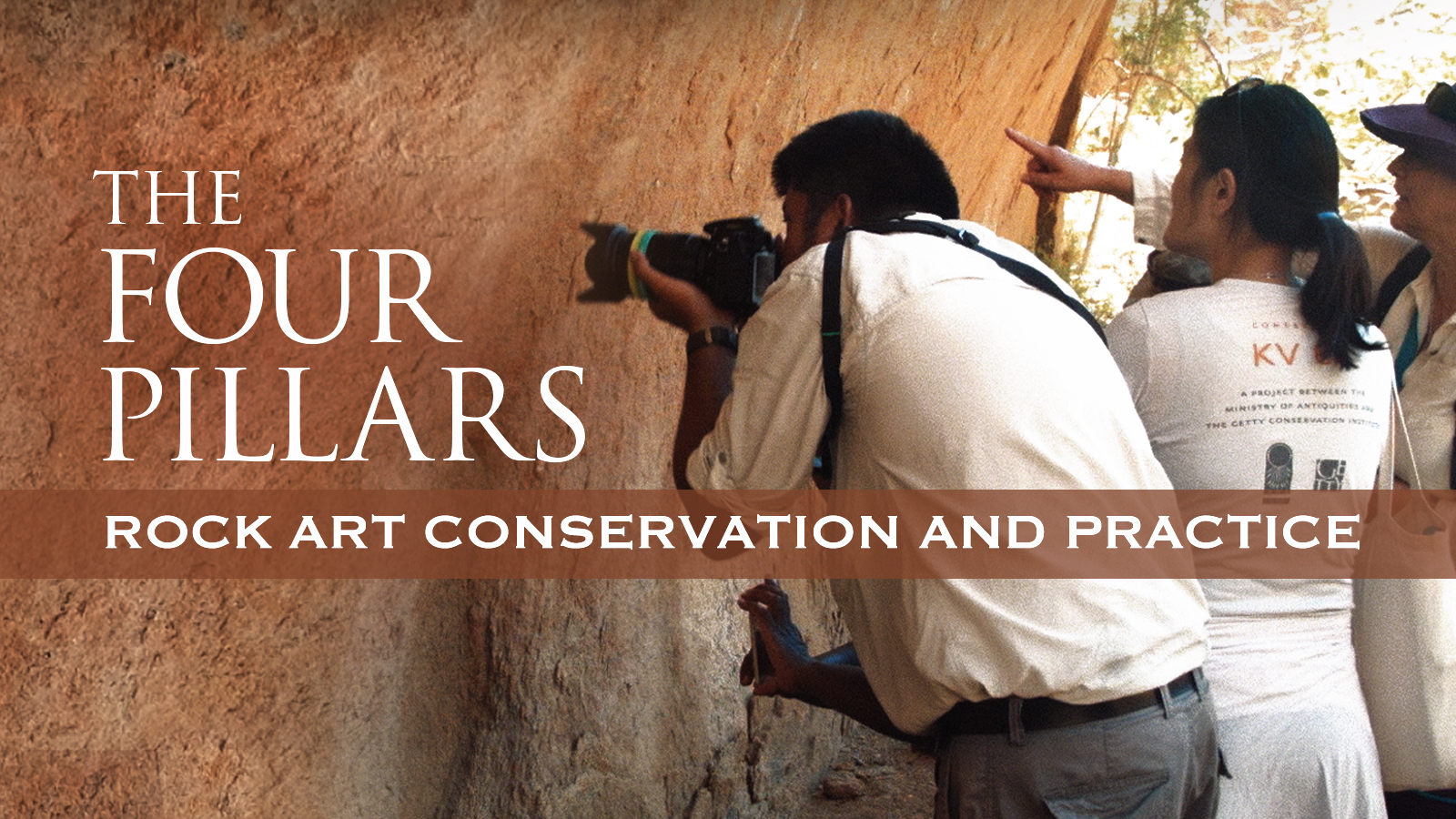
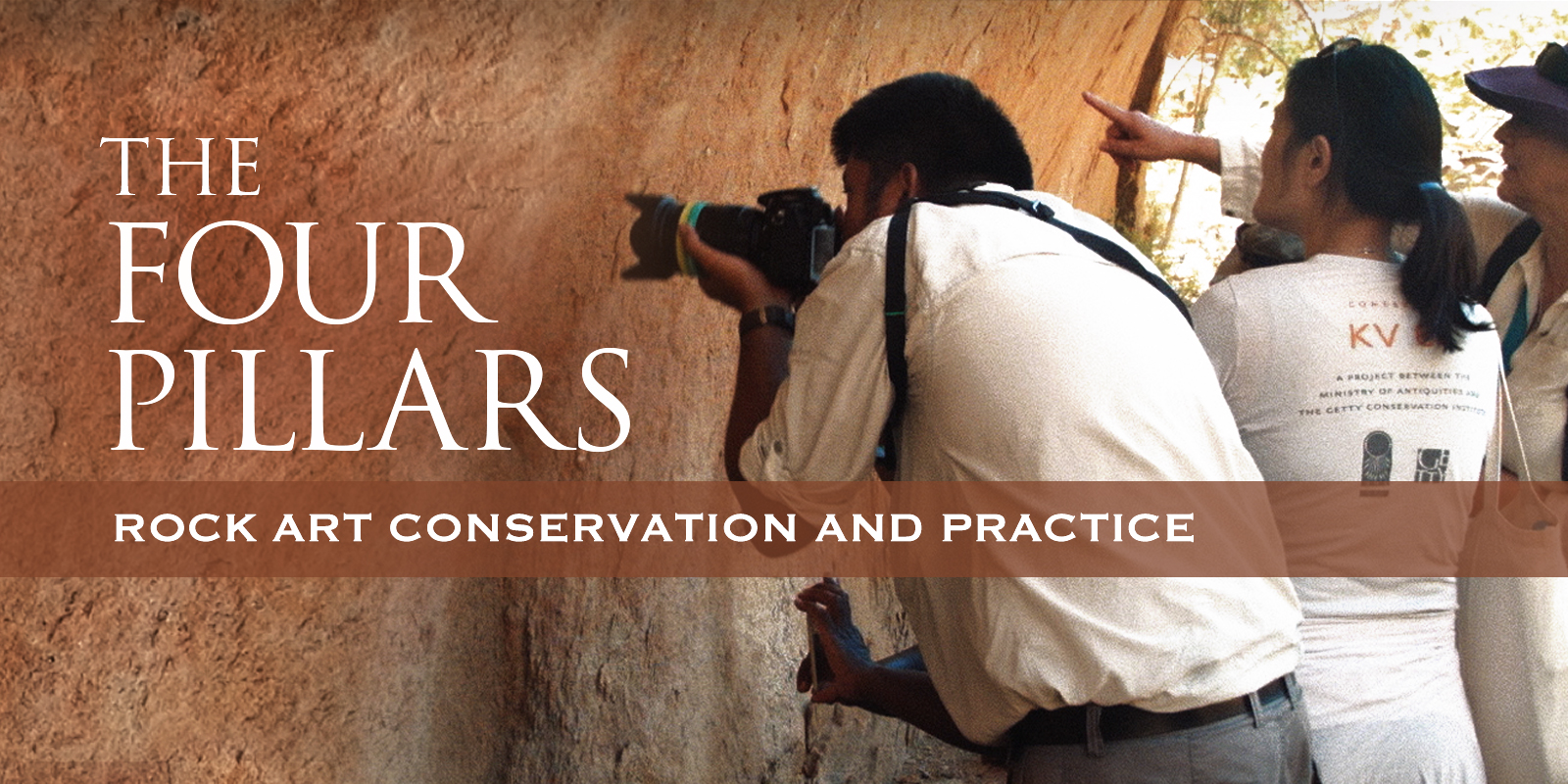
The Rock Art Network four ‘pillars’ make for strong rock art conservation in practice. This section sets out these four important areas of practice, citing a vision for what each aims to achieve, a summary of the key issues for each, a set of principles to guide practice at a more specific level and an outline of what needs to be done to improve policy and practice.
This pillar of rock art conservation emphasizes the need to encourage appropriate and well-managed economic, social and cultural development initiatives by and for indigenous, local and regional communities. Genuine community involvement can result in greater awareness of rock art, increased economic opportunities and higher quality display and interpretation for visitors.
The vision is to have:
- Economic, social and cultural initiatives which use rock art heritage approved by or in partnership with traditional owners or local communities while returning a fair benefit to them;
- Tourism to rock art sites which is fairly negotiated, carefully planned and undertaken in partnership with traditional owners and local communities;
- Traditional owners and local communities who benefit from rock art realize the value of the sites in a contemporary world and in turn become stronger protectors of their heritage; and
- Recognition of the cultural and economic value of rock art sites considered prior to decisions being made about economic development that might impact the capacity of indigenous people and local communities to gain benefit from rock art sites.
A range of issues and concerns currently prevent traditional owners and local communities from making better use of the cultural and economic assets of rock art sites:
- Rock art sites can be seen as simply curios from the past, but their value as cultural assets underpinning contemporary cultural identity and expression in addition to their value as economic assets, is poorly recognized. In order to benefit from an asset it is necessary to have the capacity to manage it in a way in which the benefit can be realized by activities which produce value for the group or community. Many traditional owners and local communities lack the skills and expertise to translate the cultural and economic value of rock art for use within current market systems;
- Rock art sites continue to be destroyed or threatened by economic activity (such as mining, agriculture and infrastructure development) before their economic contribution and social values are fully considered;
- Rock art sites make captivating attractions for visitors and are sought out by the tourism industry for its own benefit. This interest brings much pressure on both sites and communities, resulting in impacts from visitors and in all too frequent incidences of graffiti, vandalism and theft. Unfortunately, where sites are put at risk due to visitor access and tourism there is rarely adequate protection in the form of prior planning for visitor management or effective monitoring of visitor impacts;
- Access to sites for visitors and the tourism industry has not always been negotiated properly with traditional owners and local communities. This means that sites are visited by people when it is not culturally or environmentally appropriate and where there is inadequate recognition of and benefit for traditional owners and local communities;
- Rock art inherently contains images which are copied, transmitted and used for commercial gain. Indigenous intellectual property rights are often not adequately recognized and traditional owners lack the capacity to manage their intellectual property in relation to complex contemporary social, legal and global communications issues;
- Where traditional owners and local communities desire to create benefit by developing tourism to rock art sites, there is a lack of advice and assistance on how best to develop tourism products and tourism enterprises, while at the same time managing sites effectively to reduce the risks associated with visitor impacts;
- When tourism initiatives are developed, many unrealistic expectations can emerge in the communities as to the economic or other benefits that they hope will flow. If many people are involved, distribution of profit can quickly be diluted. Perceptions of benefit can be distorted and there can be negative social effects, such as changes in status and community relationships which can be very damaging to communities if not handled carefully; and
- One of the best ways for traditional owners and local communities to benefit from rock art sites is to learn skills in tour guiding and high quality communication and interpretation. In areas where there is significant rock art heritage, there is a lack of appropriately designed and delivered training programs to assist traditional owners and local communities.
The following principles should be used to guide community development initiatives and business at rock art sites:
Recognition for values and benefits of rock art
Where rock art sites are proposed to be impacted by development activity their long term cultural and economic value and potential benefits of sites must be considered in making land use decisions at a local, regional and national level.
Community engagement in development initiatives and opportunities
Traditional owners and local communities must be engaged in development initiatives from the earliest possible stage. Initiatives should start small and grow based on experience and opportunity.
Fair trade for rock art
Where there is tourism to rock art sites, or imagery from rock art is used for other purposes, (particularly commercial uses), there should be adequate recognition and benefit provided for both the traditional owners and custodians of that heritage and for the ongoing management and maintenance programs for the art.
Realistic expectations for tourism
Tourism businesses taking people to rock art sites rarely make a great deal of money. It can be challenging to attract customers, benefits may accrue slowly and not everyone can always be directly involved. Community expectations should be encouraged to be modest, for development to proceed step-by-step and for development issues to be realistically and fully discussed in community forums.
Train and develop skills and experience
Training and skill development programs should assist local communities to gain greater benefit from rock art sites in a way that minimizes impacts and maximises sustainable outcomes for development.
Ensure tourism benefits community and conservation
Profits made from all tourism businesses that use rock art sites should include a component that is directed to support conservation and management activities, including the maintenance of associated intangible heritage.
Using new technology wisely (above): Technology is always creating new opportunities to build awareness of rock art and make greater use of research efforts for public education. The Rock Art Mobile Project (RAMP) was undertaken by the International Centre for Cultural and Heritage Studies, at Newcastle University in the United Kingdom in 2010/11. The project brings this information directly to mobile phones in the Northumberland countryside. RAMP focuses on three key rock art areas carefully chosen on the strength and diversity of their rock art, their accessibility and, crucially, their ability to withstand visitor numbers. The system brings together photographs, diagrams and information from research databases with commentaries about rock art from various visitors and includes downloadable maps and audio tracks. The system was extensively tested with users and has the ability to collect information on how users are accessing the information as well as generate ‘visitor book’ style feedback from visitors.
Building local skills (above): Face- to-face interpretation is by far the most effective way to develop appreciation of rock art. At Mutawintji National Park in Western New South Wales, Australia, local Aboriginal people are employed both as rangers and as specialist guides. This creates valuable employment in a remote area and helps develop life and communication skills which enable Aboriginal people to move into other employment opportunities.
Recognizing inspiring leadership (above): Jeffrey Lee (left), A Djok senior traditional owner and Stewart Gangale (right) on behalf of Yvonne Margarula receive Environmental Awards for their commitment to protecting their country and many rock art sites from uranium mining. Jeffrey Lee has been a lifelong advocate of the importance of protecting rock art. Despite the potential of receiving hundreds of millions of dollars of royalties from a uranium mine on his clan’s land, Jeffrey made the decision to have the land included in Kakadu National Park. This monumental decision was a gift to the nation and to the world. His actions have been a source of inspiration for people from around the world and led to him receiving a key national award, Member of the Order of Australia (AM) in January 2012.
Community benefit (above): Members of the community at Makgabeng in Limpopo Province, South Africa, are establishing a community- based project that includes taking visitors to rock art sites. In 2013, the community welcomed Australian visitors to their village. Women prepared traditional foods for the visitors to sample. Songs were sung and the making of re with two sticks was demonstrated. Trained guides conducted tours to one of the rock painting sites and explained its historical signi cance.
State of the art interpretation (above): Located near Ulsan City in South Korea, the highly signi cant Bangudae petroglyph site is registered as a National Treasure and has international signi cance as one of the oldest depictions of humans whaling possibly as old as 7,000 BP. The rock art panels are dif cult to view at close range and a state of the art museum has been built at an appropriate distance from the site. High quality interpretation of the site is achieved using replicas, interactive digital video screens and contemporary artworks.
Telling the story to visitors (above): The presentation and interpretation of rock art sites is an important way of building awareness of rock art that can provide an educational outcome that at the same time bene ts local economies through expanded tourism opportunities. Interpretation must re ect the cultural signi cance of the site. At Ewaninga in Central Australia, traditional custodians of an important petroglyph site make visitors feel welcome through the sign. They provide enough information to appreciate the site’s cultural values while not jeopardizing any detailed sacred cultural information that should not be released.
Education, training and building local capacity
1. Awareness and knowledge about the values of rock art and the need for its protection and preservation needs to start at the local level to develop a strong sense of stewardship and to ensure that younger generations appreciate its importance in cultural inheritance, identity and creative stimulus. Successful projects at the local level need to be shared regionally, nationally, and internationally to encourage others.
2. Awareness and knowledge about the values of rock art and the opportunities its protection provides for the future need to be directed specifically at local leaders and decision-makers to ensure communities are well informed about rock art and the role it can play in community cultural and economic development.
3. Training and capacity building for local people to act as guides to sites is needed. The high-quality accredited training programs developed and run in southern Africa can act as a model to be adapted and made more widely available.
4. Training and capacity-building in rock art management and conservation need to be provided to local people working as rangers, guards, and site custodians.
5. Training and capacity-building programs for communities wanting to develop tourism initiatives or businesses should be available. The participatory approaches used to support traditional owners and local community tourism businesses in Australia can act as a model to be adapted and made more widely available.
Provision of access to expertise and advice
6. Contact points for local communities wanting assistance to develop tourism businesses or help with other development issues relating to rock art should be identified and promoted. People with experience in assisting communities in appropriate tourism and development at rock art sites should be found through such access points.
7. Free external advice and assistance in the form of volunteer placements and professional pro-bono services should be sought through volunteer organizations or directly with relevant professionals as a form of community service assistance. This can be especially useful for legal services (including to protect intellectual property), accounting, design, website support, and marketing and communications. Means to link local communities with these services need to be improved.
8. Providers of government services should recognize that local communities get frustrated with different sources of advice that are often highly compartmentalized and are not able to offer suitable pathways to facilitate progress for development projects. Avenues for facilitation and mentoring over longer timeframes are needed to assist communities to progress through the many challenges which inhibit and in many cases prevent economic development.
Develop and instill policies and guidelines to assist local community development
9. Policies, protocols, and guidelines that direct efforts to use rock art heritage for economic and cultural development should be available through local, regional and national agencies responsible for cultural heritage protection and land management. This includes making sure that anyone who wants to develop tourism or other projects using or affecting rock art does so by following correct procedures.
→ Members and affiliated institutions of the Rock Art Network
by
George Nash
5/09/2024 Recent Articles
→ Sigubudu: Paintings of people with guns in the northern uKhahlamba-Drakensberg
by Aron Mazel
22/07/2024
by Richard Kuba
13/06/2024
by Meenakshi Dubey-Pathak
8/03/2024
by Rock Art Network
6/02/2024
by Rock Art Network
14/12/2023
by Sam Challis
5/12/2023
by Aron Mazel
30/11/2023
by Sam Challis
21/11/2023
by Sam Challis
15/11/2023
by Sam Challis
10/11/2023
by Rock Art Network
6/11/2023
by Rock Art Network
3/11/2023
by Aron Mazel
2/11/2023
by Meenakshi Dubey-Pathak
26/09/2023
by Paul Taçon
24/08/2023
by Aron Mazel
13/06/2023
by Paul Taçon
5/06/2023
by Paul Taçon
15/03/2023
by George Nash
14/03/2023
by Noel Hidalgo Tan
10/02/2023
by George Nash
01/02/2023
by Meenakshi Dubey-Pathak, Pilar Fatás Monforte
29/11/2022
by Aron Mazel, George Nash
21/09/2022
by Paul S.C. Taçon, Sally K. May, Ursula K. Frederick, Jo McDonald
07/07/2022
by Meenakshi Dubey-Pathak
26/07/2022
by Paul Taçon
20/07/2022
by David Coulson
16 June 2022
by Paul Taçon
25 April 2022
by Noel Hidalgo Tan
20 April 2022
by Meenakshi Dubey-Pathak
14 March 2022
by Carolyn Boyd & Pilar Fatás
02 March 2022
by David Coulson
07 February 2022
by Johannes H. N. Loubser
06 February 2022
by Meenakshi Dubey-Pathak
05 February 2022
by Aron Mazel
28 January 2022
by Aron Mazel
8 September 2021
by David Coulson
17 August 2021
by Ffion Reynolds
21 June 2021


by Aron Mazel
22/07/2024
by Richard Kuba
13/06/2024
by Meenakshi Dubey-Pathak
8/03/2024
by Rock Art Network
6/02/2024
by Rock Art Network
14/12/2023
by Sam Challis
5/12/2023
by Aron Mazel
30/11/2023
by Sam Challis
21/11/2023
by Sam Challis
15/11/2023
by Sam Challis
10/11/2023
by Rock Art Network
6/11/2023
by Rock Art Network
3/11/2023
by Aron Mazel
2/11/2023
by Meenakshi Dubey-Pathak
26/09/2023
by Paul Taçon
24/08/2023
by Aron Mazel
13/06/2023
by Paul Taçon
5/06/2023
by Paul Taçon
15/03/2023
by George Nash
14/03/2023
by Noel Hidalgo Tan
10/02/2023
by George Nash
01/02/2023
by Meenakshi Dubey-Pathak, Pilar Fatás Monforte
29/11/2022
by Aron Mazel, George Nash
21/09/2022
by Paul S.C. Taçon, Sally K. May, Ursula K. Frederick, Jo McDonald
07/07/2022
by Meenakshi Dubey-Pathak
26/07/2022
by Paul Taçon
20/07/2022
by David Coulson
16 June 2022
by Paul Taçon
25 April 2022
by Noel Hidalgo Tan
20 April 2022
by Meenakshi Dubey-Pathak
14 March 2022
by Carolyn Boyd & Pilar Fatás
02 March 2022
by David Coulson
07 February 2022
by Johannes H. N. Loubser
06 February 2022
by Meenakshi Dubey-Pathak
05 February 2022
by Aron Mazel
28 January 2022
by Aron Mazel
8 September 2021
by David Coulson
17 August 2021
by Ffion Reynolds
21 June 2021
Friend of the Foundation


by Aron Mazel
22/07/2024
by Richard Kuba
13/06/2024
by Meenakshi Dubey-Pathak
8/03/2024
by Rock Art Network
6/02/2024
by Rock Art Network
14/12/2023
by Sam Challis
5/12/2023
by Aron Mazel
30/11/2023
by Sam Challis
21/11/2023
by Sam Challis
15/11/2023
by Sam Challis
10/11/2023
by Rock Art Network
6/11/2023
by Rock Art Network
3/11/2023
by Aron Mazel
2/11/2023
by Meenakshi Dubey-Pathak
26/09/2023
by Paul Taçon
24/08/2023
by Aron Mazel
13/06/2023
by Paul Taçon
5/06/2023
by Paul Taçon
15/03/2023
by George Nash
14/03/2023
by Noel Hidalgo Tan
10/02/2023
by George Nash
01/02/2023
by Meenakshi Dubey-Pathak, Pilar Fatás Monforte
29/11/2022
by Aron Mazel, George Nash
21/09/2022
by Paul S.C. Taçon, Sally K. May, Ursula K. Frederick, Jo McDonald
07/07/2022
by Meenakshi Dubey-Pathak
26/07/2022
by Paul Taçon
20/07/2022
by David Coulson
16 June 2022
by Paul Taçon
25 April 2022
by Noel Hidalgo Tan
20 April 2022
by Meenakshi Dubey-Pathak
14 March 2022
by Carolyn Boyd & Pilar Fatás
02 March 2022
by David Coulson
07 February 2022
by Johannes H. N. Loubser
06 February 2022
by Meenakshi Dubey-Pathak
05 February 2022
by Aron Mazel
28 January 2022
by Aron Mazel
8 September 2021
by David Coulson
17 August 2021
by Ffion Reynolds
21 June 2021
Friend of the Foundation
